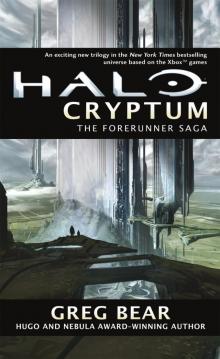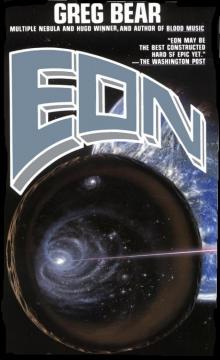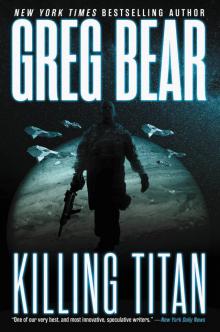Hardfought Read online
Page 6
“That’s the only way we’re different? They’re old, we’re not so old? I don’t understand.”
“Nor do I, entirely.”
“Well, finally!”‘
“The Senexi,” Clevo continued, unperturbed, “long ago needed only gas giant planets like their homeworlds. They lived in peace for billions of years before our world was formed. But as they moved from star to star, they learned uses for other types of worlds. We were most interested in rocky Earth like planets. Gradually we found uses for gas giants, too. By the time we met, both of us encroached on the other’s territory. Their technology is so improbable, so unlike ours, that when we first encountered them we thought they must come from another geometry.”
“Where did you learn all this?” Prufrax squinted at him suspiciously.
“I’m no longer a hawk,” he said, “but I was too valuable just to discard. My experience was too broad, my abilities too useful. So I was placed in research. It seems a safe place for me. Little contact with my comrades.” He looked directly at her. “We must try to know our enemy, at least a little.”
“That’s dangerous,” Prufrax said, almost instinctively.
“Yes, it is. What you know, you cannot hate.”
“We must hate,” she said. “It makes us strong. Senexi hate.”
“They might,” he said. “But, sometime, wouldn’t you like to…sit down and talk with one, after a battle? Talk with a fighter? Learn its tactic, how it bested you in one move, compare—”
“No!” Prufrax shoved off rapidly down the tube. “We’re shifting now. We have to get ready.”
She’s smart. She’s leaving him. He’s crazy.
—Why do you think that?
—He would stop the fight, end the Zap.
—But he was a hawk.
—And hawks became glovers, I guess. But glovers go wrong, too.
?
Did you know they used you? How you were used?
—That’s all blurred now.
—She’s doomed if she stays around him. Who’s that?
—Someone is listening with us.
Recognize?
No, gone now.
The next battle was bad enough to fall into the hellfought. Prufrax was in her fightsuit, legs drawn up as if about to kick off. The cruiser exited sponge space and plunged into combat before sponge space supplements could reach full effectiveness. She was dizzy, disoriented. The overhawks could only hope that a switch from biologic to cyber would cure the problem.
She didn’t know what they were attacking. Tactic was flooding the implant, but she was only receiving the wash of that; she hadn’t merged yet. She sensed that things were confused. That bothered her. Overs did not feel confusion.
The cruiser was taking damage. She could sense at least that, and she wanted to scream in frustration. Then she was ordered to merge with the implant. Biologic became cyber. She was in the Know.
The cruiser had reintegrated above a gas giant planet. They were seventy nine thousand kilometers from the upper atmosphere. The damage had come from ice mines chunks of Senexi treated water ice, altered to stay in sponge space until a human vessel integrated nearby. Then they emerged, packed with momentum and all the residual instability of an unsuccessful exit into status geometry. Unsuccessful for a ship, that is—very successful for a weapon.
The ice mines had given up the overness of the real within range of the cruiser and had blasted out whole sections of the hull. The launch lanes had not been damaged. The fighters lined up on their beams and were peppered out into space, spreading in the classic sword flower.
The planet was a cold nest. Over didn’t know what the atmosphere contained, but Senexi activity had been high in the star system, concentrating on this world. Over had decided to take a chance. Fighters headed for the atmosphere. The cruiser began planting singularity eggs. The eggs went ahead of the fighters, great black grainy ovoids that seemed to leave a trail of shadow—the wake of a birthing disruption in status geometry that could turn a gas giant into a short lived sun.
Their time was limited. The fighters would group on entry sleds and descend to the liquid water regions where Senexi commonly kept their upwelling power plants. The fighters would first destroy any plants, loop into the liquid ammonia regions to search for hidden cuckoos, then see what was so important about the world.
She and five other fighters mounted the sled. Growing closer, the hazy clear regions of the atmosphere sparkled with Senexi sensors. Spiderweb beams shot from the six sleds to down the sensors. Buffet began. Scream, heat, then a second flower from the sled at a depth of two hundred kilometers. The sled slowed and held station. It would be their only way back. The fightsuits couldn’t pull out of such a large gravity well.
She descended deeper. The pale, bloated beacon of the red star was dropping below the second cloudtops, limning the strata in orange and purple. At the liquid ammonia level she was instructed to key in permanent memory of all she was seeing. She wasn’t “seeing” much, but other sensors were recording a great deal, all of it duly processed in her implant. “There’s life here,” she told herself. Indigenous life. Just another example of Senexi disregard for basic decency: they were interfering with a world developing its own complex biology.
The temperature rose to ammonia vapor levels, then to liquid water. The pressure on the fightsuit was enormous, and she was draining her stores much more rapidly than expected. At this level the atmosphere was particularly thick with organics.
Senexi snakes rose from below, passed them in altitude, then doubled back to engage. Prufrax was designated the deep diver; the others from her sled would stay at this level in her defense. As she fell, another sled group moved in behind her to double the cover.
She searched for the characteristic radiation curve of an upwelling plant. At the lower boundary of the liquid water level, below which her suit could not safely descend, she found it.
The Senexi were tapping the gas giant’s convection from greater depths than usual. Ten kilometers above the plant, almost undetectable, hung another object with an uncharacteristic curve. The power plant was feeding its higher companion with tight energy beams.
She slowed. Two other fighters, disengaged from the brief skirmish above, took backup positions a few dozen kilometers higher. Her implant searched for an appropriate tactic. She would avoid the zero angle phase for the moment, go in for reconnaissance. She could feel sound pouring from the plant and its companion—rhythmic, not waste noise, but deliberate. And homing in on that sound were waves of large vermiform organisms, like chains of gas filled sausage. They were dozens of meters long, two meters at their greatest thickness, shaped vaguely like the Senexi snake fighters. The vermiforms were native, and they were being lured into the uppermost floating structure. None were emerging. Her backups spread apart, descended, and drew up along her flanks.
She made her decision almost immediately. She could see a pattern in the approach of the natives. If she fell into the pattern, she might be able to enter the structure unnoticed.
It’s a grinder. She doesn’t recognize it.
—What’s a grinder?
—She should make the Zap! It’s an ugly thing; Senexi use them all the time. Net a planet with grinders, like a cuckoo, but for larger operations.
The creatures were being passed through separator fields. Their organics fell from the bottom of the construct, raw material for new growth-Senexi growth. Their heavier elements were stored for later harvest.
With Prufrax in their midst, the vermiforms flew into the separator. The interior was hundreds of meters wide, lead white walls with flat gray machinery floating in a dust haze, full of hollow noise, the distant bleats of vermiforms being slaughtered. Prufrax tried to retreat, but she was caught in a selector field. Her suit bucked and she was whirled violently, then thrown into a repository for examination. She had been screened from the separator; her plan to record, then destroy, the structure had been foiled by an automatic filter.
/>
“Information sufficient.” Command logic programmed into the implant before launch was now taking over. “Zero over logicangle phase both plant and adjunct.” She was drifting in the repository, still slightly stunned. Something was fading. Cyber was hissing in and out; the over logic commands were being scrambled. Her implant was malfunctioning and was returning control to biologic. The selector fields had played havoc with all cyber functions, down to the processors in her weapons.
Cautiously she examined the down systems one by one, determining what she could and could not do. This took as much as thirty seconds an astronomical time on the implant’s scale.
She still could use the phase weapon. If she was judicious and didn’t waste her power, she could cut her way out of the repository, maneuver and work with her escorts to destroy both the plant and the separator. By the time they returned to the sleds, her implant might have rerouted itself and made sufficient repairs to handle defense. She had no way of knowing what was waiting for her if when she escaped, but that was the least of her concerns for the moment.
She tightened the setting of the phase beam and swung her fightsuit around, knocking a cluster of junk ice and silty phosphorescent dust. She activated the beam. When she had a hole large enough to pass through, she edged the suit forward, beamed through more walls and obstacles, and kicked herself out of the repository into free fall. She swiveled and laid down a pattern of wide angle beams, at the same time relaying a message on her situation to the escorts.
The escorts were not in sight. The separator was beginning to break up, spraying debris through the almost opaque atmosphere. The rhythmic sound ceased, and the crowds of vermiforms began to disperse.
She stopped her fall and thrust herself several kilometers higher directly into a formation of Senexi snakes. She had barely enough power to reach the sled, much less fight and turn her beams on the upwelling plant.
Her cyber was still down.
The sled signal was weak. She had no time to calculate its direction from the inertial guidance cyber. Besides, all cyber was unreliable after passing through the separator.
Why do they fight so well? Clevo’s question clogged her thoughts. Cursing, she tried to blank and keep all her faculties available for running the fightsuit. When evenly matched, you cannot win against your enemy unless you understand them. And if you truly understand, why are you fighting and not talking? Clevo had never told her that—not in so many words. But it was part of a string of logic all her own.
Be more than an automaton with a narrow range of choices. Never underestimate the enemy. Those were old Grounds dicta, not entirely lost in the new training, but only emphasized by Clevo.
If they fight as well as you, perhaps in some ways they fight—think like you do. Use that.
Isolated, with her power draining rapidly, she had no choice. They might disregard her if she posed no danger. She cut her thrust and went into a diving spin. Clearly she was on her way to a high pressure grave. They would sense her power levels, perhaps even pick up the lack of field activity if she let her shields drop. She dropped the shields. If they let her fall and didn’t try to complete the kill—if they concentrated on active fighters above—she had enough power to drop into the water vapor regions, far below the plant, and silently ride a thermal into range. With luck, she could get close enough to lay a web of zero angle phase and take out the plant.
She had minutes in which to agonize over her plan. Falling, buffeted by winds that could knock her kilometers out of range, she spun like a vagrant flake of snow.
She couldn’t even expend the energy to learn if they were scanning her, checking out her potential.
Perhaps she underestimated them. Perhaps they would be that much more thorough and take her out just to be sure. Perhaps they had unwritten rules of conduct like the ones she was using, taking hunches into account. Hunches were discouraged in Grounds training—much less reliable than cyber.
She fell. Temperature increased. Pressure on her suit began to constrict her air supply. She used fighter trancing to cut back on her breathing.
Fell.
And broke the trance. Pushed through the dense smoke of exhaustion. Planned the beam web. Counted her reserves. Nudged into an updraft beneath the plant. The thermal carried her, a silent piece of paper in a storm, drifting back and forth beneath the objective. The huge field intakes pulsed above, lightning outlining their invisible extension. She held back on the beam.
Nearly faded out. Her suit interior was almost unbearably hot.
She was only vaguely aware of laying down the pattern. The beams vanished in the murk. The thermal pushed her through a layer of haze, and she saw the plant, riding high above clear atmosphere turbulence. The zero angle phase had pushed through the field intakes, into their source nodes and the plant body, surrounding it with bright blue Cherenkov. First the surface began to break up, then the middle layers, and finally key supports. Chunks vibrated away with the internal fury of their molecular, then atomic, then particle disruption. Paraphrasing Grounds description of beam action, the plant became less and less convinced of its reality. “Matter dreams,” an instructor had said a decade before. “Dreams it is real, maintains the dream by shifting rules with constant results. Disturb the dreams, the shifting of the rules results in inconstant results. Things cannot hold.”
She slid away from the updraft, found another, wondered idly how far she would be lifted. Curiosity at the last. Let’s just see, she told herself; a final experiment.
Now she was cold. The implant was flickering, showing signs of reorganization. She didn’t use it. No sense expanding the amount of time until death. No sense
at all.
The sled, maneuvered by one remaining fighter, glided up beneath her almost unnoticed.
Aryz waited in the stillness of a Senexi memory, his thinking temporarily reduced to a faint susurrus. What he waited for was not clear.
—Come.
The form of address was wrong, but he recognized the voice. His thoughts stirred, and he followed the nebulous presence out of Senexi territory.
Know your enemy.
Prufrax…the name of one of the human shapes sent out against their own kind. He could sense her presence in the mandate, locked into a memory store. He touched on the store and caught the essentials—the grinder, the updraft plant, the fight from Prufrax’s viewpoint.
—Know how your enemy knows you.
He sensed a second presence, similar to that of Prufrax. It took him some time to realize that the human captive was another form of the shape, a reproduction of the…
Both were reproductions of the female whose image was in the memory store. Aryz was not impressed by threes—Senexi mysticism, what had ever existed of it, had been preoccupied with fives and sixes—but the coincidence was striking.
Know how your enemy sees you.
He saw the grinder processing organics the vermiform natives in preparation for a widespread seeding of deuterium gatherers. The operation had evidently been conducted for some time; the vermiform populations were greatly reduced from their usual numbers. Vermiforms were a common type species on gas giants of the sort depicted. The mutated shape nudged him into a particular channel of the memory, that which carried the original Prufrax’s emotions. She had reacted with disgust to the Senexi procedure. It was a reaction not unlike what Aryz might feel when coming across something forbidden in Senexi behavior. Yet eradication was perfectly natural, analogous to the human cleansing of food before eating.
It’s in the memory. The vermiforms are intelligent. They have their own kind of civilization. Human action on this world prevented their complete extinction by the Senexi.
So what matter they were intelligent? Aryz responded. They did not behave or think like Senexi, or like any species Senexi find compatible. They were therefore not desirable. Like humans.
You would make humans extinct?
—We would protect ourselves from them.
—Who damages
whom most?
Aryz didn’t respond. The line of questioning was incomprehensible. Instead he flowed into the memory of Prufrax, propelled by another aspect of complete freedom, confusion.
The implant was replaced. Prufrax’s damaged limbs and skin were repaired or regenerated quickly, and within four wakes, under intense treatment usually reserved only for overs, she regained all her reflexes and speed. She requested liberty of the cruiser while it returned for repairs. Her request was granted.
She first sought Clevo in the designated research area. He wasn’t there, but a message was, passed on to her by a smiling young crew member. She read it quickly:
“You’re free and out of action. Study for a while, then come find me. The old place hasn’t been damaged. It’s less private, but still good. Study! I’ve marked highlights.”
She frowned at the message, then handed it to the crew member, who duly erased it and returned to his duties. She wanted to talk with Clevo, not study.
But she followed his instructions. She searched out highlighted entries in the ship’s memory store. It was not nearly as dull as she had expected. In fact, by following the highlights, she felt she was learning more about Clevo and about the questions he asked.
Old literature was not nearly as graphic as fibs, but it was different enough to involve her for a time. She tried to create imitations of what she read, but erased them. Nonfib stories were harder than she suspected. She read about punishment, duty; she read about places called heaven and hell, from a writer who had died tens of thousands of years before. With ed supplement guidance, she was able to comprehend most of what she read. Plugging the store into her implant, she was able to absorb hundreds of volumes in an hour.
Some of the stores were losing definition. They hadn’t been used in decades, perhaps centuries.
Halfway through, she grew impatient. She left the research area. Operating on another hunch, she didn’t go to the blister as directed, but straight to memory central, two decks inboard the research area. She saw Clevo there, plugged into a data pillar, deep in some aspect of ship history. He noticed her approach, unplugged, and swiveled on his chair. “Congratulations,” he said, smiling at her.

 Foundation and Chaos
Foundation and Chaos Halo: Silentium
Halo: Silentium Blood Music
Blood Music Halo: Cryptum
Halo: Cryptum Halo: Primordium
Halo: Primordium The Unfinished Land
The Unfinished Land Hardfought
Hardfought Hull Zero Three
Hull Zero Three Slant
Slant Multiverse: Exploring the Worlds of Poul Anderson
Multiverse: Exploring the Worlds of Poul Anderson Take Back the Sky
Take Back the Sky Nebula Awards Showcase 2015
Nebula Awards Showcase 2015 Machineries Of Joy
Machineries Of Joy A Martian Ricorso
A Martian Ricorso Eternity
Eternity Vitals
Vitals The Infinity Concerto
The Infinity Concerto Beyond the Farthest Suns
Beyond the Farthest Suns Moving Mars
Moving Mars Quantico
Quantico Darwin's Radio
Darwin's Radio Beyond Heaven's River
Beyond Heaven's River Star Wars - Rogue Planet
Star Wars - Rogue Planet Legacy (Eon, 1)
Legacy (Eon, 1) War Dogs: Ares Rising
War Dogs: Ares Rising Sisters
Sisters Dead Lines
Dead Lines Just Over the Horizon (The Complete Short Fiction of Greg Bear Book 1)
Just Over the Horizon (The Complete Short Fiction of Greg Bear Book 1) Eon (Eon, 2)
Eon (Eon, 2) Venging
Venging Eon
Eon City at the End of Time
City at the End of Time Psychlone
Psychlone Dead Lines, A Novel of Life... After Death
Dead Lines, A Novel of Life... After Death Eternity (Eon, 3)
Eternity (Eon, 3) Cryptum
Cryptum Corona
Corona Sleepside: The Collected Fantasies
Sleepside: The Collected Fantasies Women in Deep Time
Women in Deep Time Queen of Angels
Queen of Angels Darwin's Children
Darwin's Children Dinosaur Summer
Dinosaur Summer The Forge of God tfog-1
The Forge of God tfog-1 Foundation and Chaos f-9
Foundation and Chaos f-9 Star Wars: Rogue Planet
Star Wars: Rogue Planet The Forge of God
The Forge of God Mariposa
Mariposa Halo: Cryptum: Book One of the Forerunner Saga
Halo: Cryptum: Book One of the Forerunner Saga Strength of Stones
Strength of Stones Anvil of Stars
Anvil of Stars B00AQUQDQO EBOK
B00AQUQDQO EBOK Anvil of Stars tfog-2
Anvil of Stars tfog-2 Ares Rising 1: War Dogs
Ares Rising 1: War Dogs Rogue Planet (star wars)
Rogue Planet (star wars) The Machineries of Joy
The Machineries of Joy Far Thoughts and Pale Gods
Far Thoughts and Pale Gods Songs of Earth and Power Omnibus
Songs of Earth and Power Omnibus Killing Titan
Killing Titan Darwin's Radio d-1
Darwin's Radio d-1 Darwin's Children d-2
Darwin's Children d-2